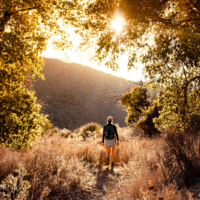By Judy A. Strekalov, Esq.
“Of all the paths you take in life, make sure a few of them are dirt” – John Muir.
As we survive this California heat wave, the time is still ripe to enjoy the long daylight-filled days with physical outdoor activities. Aside from visiting California’s lovely coastlines, the Golden State also offers around 12,000 hiking trails to enjoy, from local city trails to majestic national parks.
The onset of the COVID-19 pandemic has prompted a spike in trail-use. With this boom of hiking activities in our own backyard, injuries are bound to occur. The natural conditions present on trails, such as tree roots, rocks, holes, uneven surfaces, and wildlife are all part of the enjoyment but also part of the potential dangers.
To avoid the potential landslide of lawsuits that arise from conditions of trails, both natural and man-made, California enacted the California Recreational Trail Immunity (“Trail Immunity”), which provides public entities and some private landowners who have opened up their property for recreational use absolute immunity for potentially dangerous conditions on their land. This immunity is to encourage continued access to trails and was a public policy to avoid closures of parcels of public and private property resulting from personal injury lawsuits.
Government Code Section 831.4
The Trail Immunity is encompassed under Government Code section 831.4, adopted by Legislature to protect public land owners1. Section 831.4 precludes liability for injuries caused by the condition of unpaved roads and trails providing access to “fishing, hunting, camping, hiking, riding, including animal and all types of vehicular riding, water sports, recreational or scenic areas,” as well as for injuries caused by the condition of any paved trail, walkway, path or sidewalk located on an “easement of way which … provides access to any unimproved property.”
This immunity is absolute, meaning that a public entity may not be held liable for any condition of a trail that is used for recreational activities or accessing scenic areas. (Astenius v. State (2005) 126 Cal.App.4th 472). This immunity applies even if a trail has a dual use for both recreational and non-recreational activities.
Applications of the Trail Immunity
California Courts have also found that the California Trail Immunity Statute arises in the following scenarios, where the trail immunity covers negligent maintenance of a trail:
- In Astenius v. State of California (2005) 126 Cal. App. 4th 472, Ms. Geary died while driving an off-highway vehicle (OHV) in a State recreation area. She lost control of her OHV on an extremely rough trail, which overturned, slid down the trail, and came to rest at the bottom of a gully. The Court rejected the argument that a failure to warn of a dangerous condition removed immunity under Section 831.4, because nothing in Section 831.4 makes immunity contingent on giving proper warnings. The immunity granted by section 831.4 is absolute.
- In Farnham v. City of Los Angeles (1998) 68 Cal. App. 4th 1097, a portion of the outer pavement of a bicycle path along the perimeter of Balboa Park gave away, causing the bicyclist to be thrown into an adjacent ditch. The Court found that just because some segments of the trail allowed cross-vehicle traffic did not take it out of the meaning of a “trail.” Additionally, a paved trail still qualifies for immunity because “… the nature of the trail’s surface is irrelevant to questions of immunity,” as established in Armenio v. County of San Mateo (1994) 28 Cal.App.4th 413.
- In Giannuzzi v. State of California (1993) 17 Cal. App. 4th 462, Mr. Giannuzzi was unaware that the State had moved quantities of dirt at a bottom of a hill directly in the path of a previously established dirt trail in a vehicular recreation park. As a result, Mr. Giannuzzi suffered injuries in an attempt to avoid the dirt pilings on the path. The Court reasoned that because Mr. Giannuzzi was within the State park for recreational driving of his vehicle and was injured during the course of that activity, section 831.4 was established as a matter of law.
Test for Application of Immunity
Although the immunity is absolute, the application of the Trail Immunity is not always clear cut. One of the major considerations in applicability of the Trail Immunity is whether the injured person was required to use the trail to access the location that eventually caused them injury. If so, then whether or not the hazard was part of the trail or “condition” of the trail is part of the “integral feature” test. (Treweek v. City of Napa (2000) 85 Cal.App.4th 22.) This means that an off-trail hazard can still be considered an integral part of the trail if it is “part and essential to the full use of the ‘trail’.”
For example, a gully adjacent to a trail was considered an “integral” part of the trail if the trail is what provided access to the gully. (Amberger-Warren v. City of Piedmont (2006) 143 Cal.App.4th 1074.). Similarly, a man-made chain link fence gate that opened to a bike path was determined to be protected by the Trail Immunity because the chain link gate provided access to the trail. So, when a biker was injured by the fence as opposed to a natural condition of the trail, the property owners were still immune. (Prokop v. City of Los Angeles (2007) 150 Cal.App.4th 1332.)
Examples Where Trail Immunity Does Not Apply
If the hazard was not an “integral” feature of the property or is not necessary to access the land, a public or private entity might not be immune from liability for injuries depending on the circumstances.
In Toeppe v. City of San Diego (2017) 13 Cal. App. 5th 921, Ms. Toeppe was injured when the branch of a eucalyptus tree broke and fell on her. These eucalyptus trees were not a natural part of the land. Rather, the City had planted and maintained these eucalyptus trees in its park. Furthermore, park visitors did not need to walk the trails to access the eucalyptus trees. Visitors were able to picnic under the tree, or walk on the grass directly to the tree, without ever having to use the trail. In sum, the Court cited these main reasons for finding no immunity: (1) the eucalyptus trees were not naturally part of the terrain, but artificially planted there by the City, (2) the City had a history of maintaining these trees by trimming and pruning them, and (3) access to these trees did not require the use of the trail as to qualify under the Trail Immunity Act. Ultimately, it was not the trail at issue, but the tree itself separate and apart from the trail.
In Garcia v. American Golf Corporation (2017) 11 Cal.App.5th 532, a child was struck by a wayward golf ball while being strolled along a walkway adjacent to a golf course that was near a public trail. The Court analyzed the area surrounding the golf course and concluded that even if the trail did not exist, people would still have access to the golf course to have been potentially struck by flying golf balls. As a result of the loose causal link between the trail itself and the errant golf balls, the Court found that the trail immunity did not apply. Note that this is distinguished from Leyva v. Crockett & Company, Inc. (2017) 7 Cal.App.5th 1105, wherein the Court found that the trail immunity did apply when Mr. Leyva was struck by a golf ball while walking on a trail next to the golf course – the difference here is that, but for the trail, he would not have been next to the golf course as to have been struck to begin with.
In sum, if the use of the trail was not the only way for a potential plaintiff to have encountered the hazard/danger, then the trail immunity will likely not apply even if the injury occurred on the trail.
Proceed With Caution
As we can see, the Trail Immunity is very broad, and public and private entities are well protected from liability in most scenarios regarding the use of their trails. Ultimately, it is incumbent that all participants utilizing trails exercise caution when accessing these paved and unpaved public roads, and naturally assumes the risks associated with such use. Before you strap on your hiking boots and hit the great outdoors, do not forget that you must take care to watch your footing and your surroundings!
1Simultaneously, California adopted Civil Code Section 846, which provided private landowners immunity for injuries suffered by those who used their land for recreational purposes (as long as the private owner did not charge an entry fee). The entry fee provision is not applicable to public entities.

Judy A. Strekalov, Esq. is an Associate at Bradley, Gmelich & Wellerstein LLP. Ms. Strekalov received her J.D. from Loyola Law School, Los Angeles. While in law school, she volunteered at the Loyola Center For Conflict Resolution (LCCR) to provide mediation, conciliation, and facilitation services to the Los Angeles community. She also clerked at the California Department of Justice, Licensing Division and at the Los Angeles District Attorney’s Office, Preliminary Hearing Unit.
Prior to joining the firm, Ms. Strekalov handled all aspects of medical malpractice defense litigation up to the beginning of trial. Ms. Strekalov also has extensive experience in real property title transfers, liens, reconveyances, and recording requisites for all California counties.

